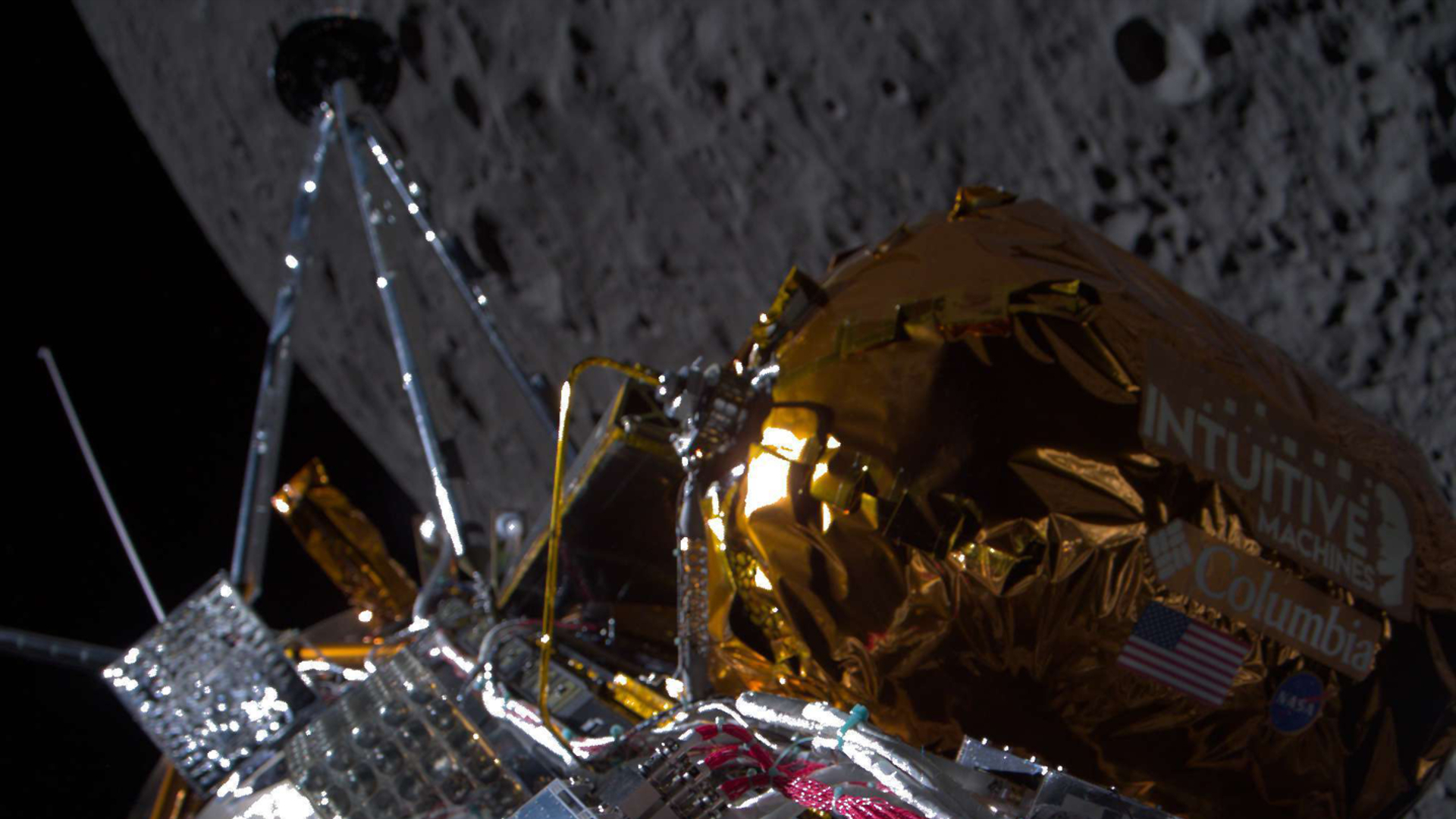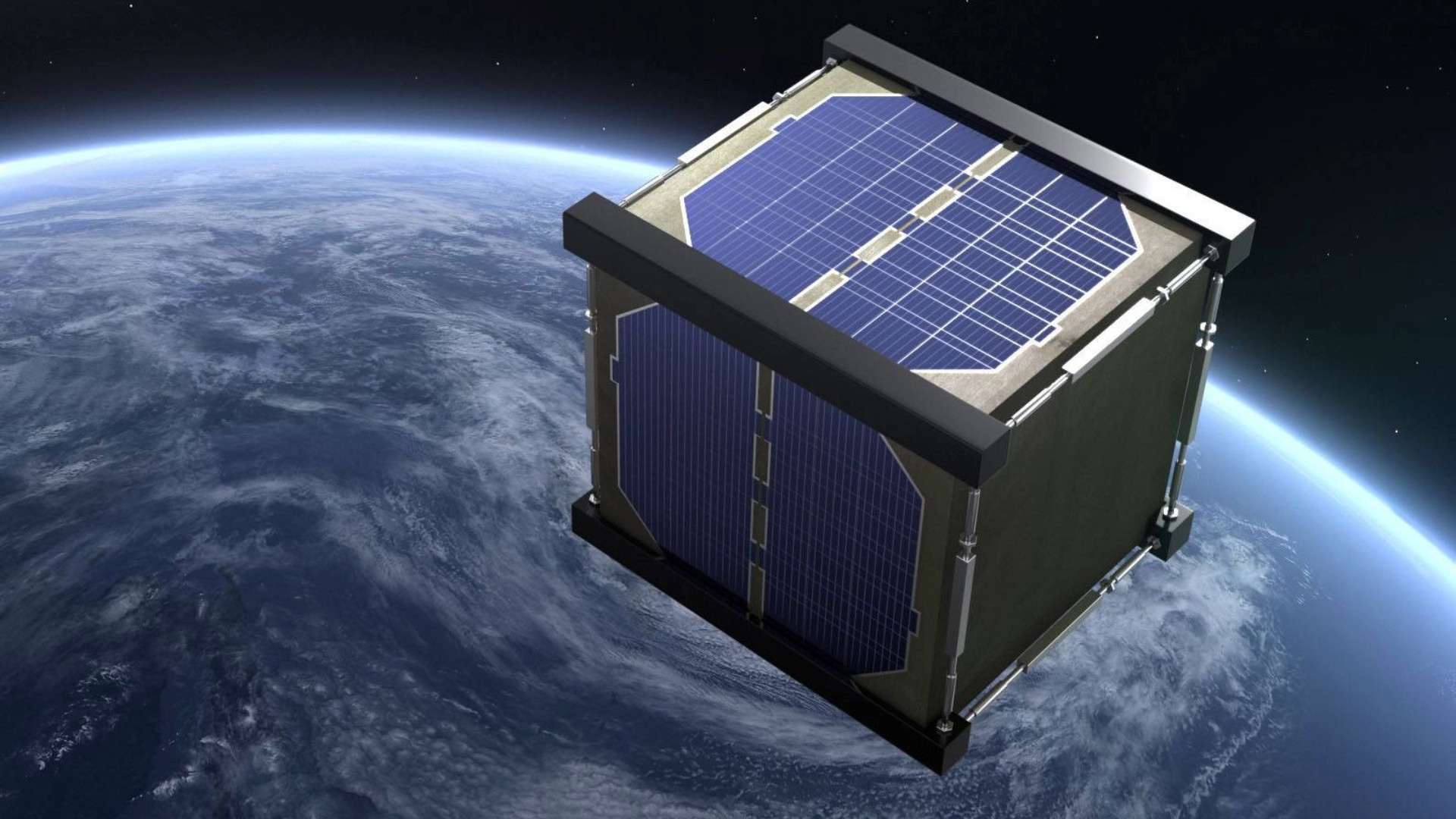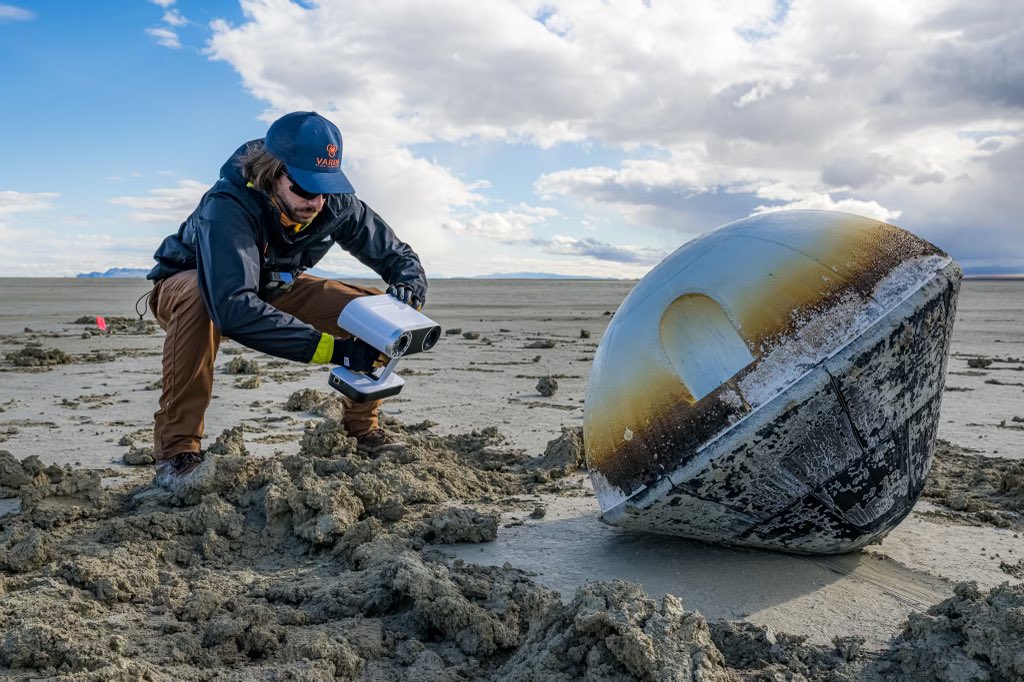
The second private mission to fly to the Moon under NASA’s Commercial Lunar Payload Services (CLPS) programme, and launched on February 15th, arrived on the lunar surface on February 22nd.
Following a successful launch, the mission – referred to as IM-1, for Intuitive Machines (the company that built the vehicle) mission 1, and the Nova-C lander itself christened Odysseus, had a slight wobbly start to its time in space after successfully being delivered into Earth orbit by a SpaceX Falcon 9 rocket.
Following its separation from the launch vehicle’s upper stage, the 675 kg Odysseus had been due to carry a “commissioning burn” of its main liquid methane / liquid oxygen (“methlox”) engine, firing it, then stopping it and then restarting it, a critical requirement of the motor if the lander was to enter lunar orbit and land. However, issues with the lander’s navigational star tracker and then with the liquid oxygen tank’s cooling lines meant the test had to be delayed until February 16th, when it was completed successfully, marking the first time a methlox propulsion system had ever been successfully re-started in space.

Following its departure from Earth, the craft had been scheduled to make three trajectory adjustment manoeuvres whilst en route to the Moon, but only required the first two, such was the accuracy with which it matched its flight plan. On February 21st, the lander performed a Lunar Orbit Insert (LOI) manoeuvre, firing the main engine for 408 seconds to slow its velocity by 88 metres per second and place it in a 92 km orbit around the Moon.
After 24 hours in orbit, returning high-resolution images of the lunar surface to Earth, the vehicle was prepared to start its decent – and the mission hit another slight hiccup: a safety switch on the primary descent laser rangefinder had not been correctly set prior to launch, leaving the lander unable to accurately determine its distance from the Moon’s surface.
To compensate, the IM team worked with NASA to allow the latter’s experimental Navigation Doppler Lidar for Precise Velocity and Range Sensing system (called simply NDL to avoid a mouthful of an acronym) carried by the lander to take over the role of the laser rangefinder (and thereby also proving the NDL’s ability to guide a vehicle to a precise landing on another celestial body). This allowed the lander to commence its descent; unfortunately, it also meant that one of the other payloads on the lander had to be powered down.

This was EagleCam, a small box of cameras developed by students and designed to be ejected from the lander when it was some 30 metres above the Moon in the hope that it would land ahead of Odysseus and provide the first-ever images of a space vehicle landing on the Moon. But the need to re-route power to NDL meant the ejection system for the camera had to be turned off.
Everything else with the descent seemed to go exactly as planned, and at 23:53 UTC on February 22nd, the lander settled on the Moon close to the crater Malapert A, about 300 km from the lunar south pole, only for another issue to occur: the mission team could not fully acquire the lander’s transmissions. After 15 minutes, it became apparent that whilst the vehicle was safely on the Moon, something was preventing it from sending a full-strength signal, leaving the mission team unable to lock-on to it. During the next several hours, the team worked to establish a firm contact with the lander – which they managed, to a degree – and obtain data on its approach and landing on the Moon, and general condition. The data received allowed them to reach a conclusion as to what had happened.
It had been thought that the 4.3 metre tall craft had made a proper vertical descent, slowing its horizontal speed to zero before lowering itself onto the Moon vertically at a rate of 3.6 km/h. But the telemetry finally obtained by the mission team revealed that at touchdown, the vehicle was vertically descending at close to 10 km/h, and moving horizontally at 3.2 km/h.

This has led Intuitive Machines to conclude the lander was crabbbing sideways immediately before landing, rather than hovering in place, and one of the landing legs snagged on a rock or lip of a crevice, causing the vehicle to gently topple onto its side. Further data suggested that in toppling, Odysseus had ended-up leaning against a rock, allowing it to communicate, but with its antenna mis-aligned.
While communications had been stabilised, as of the time of writing the piece, it was unclear how many of the lander’s science packages would be able to function successfully. Even so, the landing is both a success – the first time an operational lunar lander built and operated by the private sector has landed on another celestial body, and the first time America has returned to the surface of the Moon since Gene Cernan and Harrison Schmitt departed on Apollo 17 in 1972 – and a warning.
Like the planned SpaceX Starship Human Landing System vehicle (HLS) intended to return humans to the lunar surface as a part of the Artemis Project, Odysseus is a tall, slim vehicle in terms of its overall proportions. Even with two extra landing legs compared to the SpaceX HLS (a altogether taller vehicle with a higher centre of mass), The IM-1 mission demonstrates how just a slight horizontal drift can be sufficient for such a vehicle to topple itself where a squatter, broader vehicle probably would not have done so.
Currently, IM-1 has sufficient sunlight to remain in operation through until the latter part of the coming week, after which the sun will set relative to its location on the Moon, depriving it of energy to power its battery systems.
Wooden Wonder
Want to have more eco-friendly satellites? Then why not make them out of … wood.
No, I’m not being sarcastic nor have I gone space happy. The above proposition was first put forward in 2019/2020 by a team of Japanese researchers at Kyoto University. It was born out of concern about the on-going practice of allowing / causing expired satellites to re-enter the upper atmosphere to burn up as a result of the frictional heat created by their passage through the atmosphere.
Whilst this generally results in the destruction of the greater portion of a lump of debris entering the atmosphere and helps reduce the dangerous clutter of junk whipping around the Earth, it is not entirely “clean”: every satellite or piece of rocket that burns up in this way leaves behind a trail of alumina particles which remain suspended in the atmosphere for decades. With the explosion of the private space sector and the growing use of “constellations” of thousands of low-orbiting, expendable satellites such as the (as of January 2024) 5,289 SpaceX Starlink network, these trails or clouds of alumina particles are set to increase exponentially, potentially having an undesirable impact on the upper reaches of the denser atmosphere and the environment as a whole.
So the researchers set out to find an alternative material for making satellites – and came to the conclusion that wood might be the best. Thus, the LignoStella Space Wood Project was born.
When you use wood on Earth, you have the problems of burning, rotting and deformation, but in space, you don’t have those problems: There is no oxygen in space, so it doesn’t burn, and no living creatures live in them, so they don’t rot. Some woods are extremely durable, so we set out to see if wood could be practically applied for use in small satellite systems.
– Koji Murata, LignoStella Space Wood Project
To test their ideas, the team examined various types of wood and determined three – Erman’s birch, Japanese cherry and magnolia bovate – had the precise properties required of a satellite body: they are lightweight, strong and durable. Just how durable was demonstrated when samples of the woods were flown to the International S[ace Station (ISS) in 2022 and exposed to the vacuum of space and the unfettered blasting of solar radiation for 290 days, being returned to Earth in mid 2023.

Analysis for the samples revealed that despite the harsh conditions to which they had been exposed, they had no measurable changes in mass and showed no signs of decomposition or damage. Meanwhile, tests of the woods on Earth indicated that of the three flown on the ISS, the magnolia wood – Hoonoki in Japanese – offers the best choice in terms of “workability, dimensional stability and overall strength” for use in a satellite design.
Now, and with the involvement of the Japanese Aerospace Exploration Agency (JAXA) and America’s NASA, the researcher are aiming to launch their first wooden satellite this coming summer. Currently, the plan is to carry it to orbit aboard an Orbital Sciences Cygnus automated resupply vehicle delivering supplies and equipment to the ISS. If all goes according to plan, the Cygnus vehicle will release the little satellite into its own orbit, where it will remain for 6 months.
:focal(400x267:401x268)/https://tf-cmsv2-smithsonianmag-media.s3.amazonaws.com/filer_public/6a/53/6a53ca5e-436e-4aae-91fc-2ffdb3bd420d/img_interview_murata_03_1.jpg)
Called LignoSat-2, the vehicle is roughly the size of a cubesat – no more than 10cm on a side. Its primary purpose will be to test a number of factors in the use of wood which could dramatically change the design of such small satellites, which are growing increasingly popular in a growing number of roles. For example, wood can be penetrated by electromagnetic waves, so delicate and awkward elements of a satellite – sensors and antennae – could be mounted inside the satellite’s overall structure, helping to protect them whilst simplifying the overall design of the vehicle.
The overall durability of wood will also be monitored, as will be the eventual destruction of the satellite, the majority of which should burn-up “cleanly” in the atmosphere at the end of the mission, leaving only minute amounts of trace particulates.
One of the missions of the satellite is to measure the deformation of the wooden structure in space. Wood is durable and stable in one direction but may be prone to dimensional changes and cracking in the other direction.
– Koji Murata, LignoStella Space Wood Project
The LignoSat project is not the only team to consider the use of wood in satellites. Working entirely independently to them, a consortium of researchers and businesses out of Finland, supported by the European Space Agency (ESA) and Rocket Lab were developed a similar project with a cubesat built primarily out of plywood and called WISA Woodsat.
Heavily promoted and slated to fly in 2022, the project as (and still is) billed as the “world’s first wooden satellite”. However, since mid-2022 the project has been stalled, with no website updates or further information from ESA since April of that year.
Medical Crystals Grown in Space
One of the major promises of near-Earth space operations has long been that of leveraging the micro-gravity environment in the manufacture of ultra-pure drugs and the components used within them. Multiple experiments in this regard have been carried out over the decades, using facilities on space stations such as Mir and the ISS, or aboard the space shttle when it flew the European Spacelab, and so on.
Now a US company is looking to take matters a stage further – and have just successfully recovered their first attempt.

Varda Space Industries is a relative new US start-up which has grand designs on microgravity manufacturing involving pharmaceuticals, fibre optics and computer chips. And they’ve moved fast. In 2021 the company purchased three Photon satellite buses from Rocket Lab to provide power, propulsion and navigation capabilities for the company’s “Winnebago” automated production satellites, the first of which – Winnebago-1 (W-1) – launched in June 2023, as a payload within a SpaceX Falcon 9 Transporter rideshare launch.
Originally, the craft was supposed to spend three months in orbit, growing exceptionally pure, “near-perfect” crystals used in an anti-viral medication called Ritonavir, a highly active antiretroviral therapy (HAART). The selection of a pharmaceutical product for the first Winnebago mission as this is seen as the largest market which might benefit from the benefits of microgravity production techniques. However, the capsule remained in orbit far longer than intended, thanks to the US Department of Defense (DOD), having originally agreed in principle to allowing Varda to use its Utah Test and Training Range (UTTR) as their landing site, withdrew that permission after the mission had been launched.
Thus began a multi-month series of negotiations involving the DOD, the Federal Aviation Administration (FAA), Varda and Rocket Lab to try and reach an agreement on the use of UTTR to recover the capsule. So protracted did this became that Varda, rather than lose their product, actually started looking at overseas recovery options such as the Koonnibba Test Range in Australia.

On February 14th, however, the required agreement to use UTTR was reached and the FAA expedited granting Varda a licence to carry out a controlled re-entry into, and descent through, Earth’s atmosphere. As a result, on February 21st, 2024, Varda were finally able to bring their W-1 mission home on February 21st, 2024.
After the Photon buss had been used in a de-orbit manoeuvre, the capsule containing the automated manufacturing plant successfully re-entered the atmosphere and deployed its main parachute, touching down within the UTTR at 21:40 UTC in February 21st, marking the second time the range has been used for the recovery of space science capsules – the first being NASA’s OSIRIS-REx capsule, bringing samples from asteroid Bennu back to Earth for analysis.
Following touchdown, the capsule was subject to analysis and cooling prior to being harnessed to a helicopter for transfer to a Varda receiving station where it could be opened in suitable lab conditions, and the crystals produced initially assessed.
From there, the Ritonavir vials onboard the spacecraft will be shipped to our collaborators Improved Pharma for post-flight characterisation. Additionally, data collected throughout the entirety of the capsule’s flight — including a portion where we reached hypersonic speeds — will be shared with the Air Force and NASA under a contract Varda has with those agencies.
– Varda statement
No information has been given on the next Varda mission, called Winnebago-2, or its likely payload.